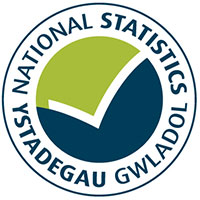Data on the number of households applying to local authorities for housing assistance under the Housing Wales Act 2014 and the number of households in temporary accommodation for July to September 2019.
This is not the latest release in the series: Homelessness statistics
Main points (a)
Quarterly data is sometimes revised at the end of the financial year and therefore the data should be treated with caution.
Households threatened with homelessness (b)
2,400 households were threatened with homelessness within 56 days. This is similar to last quarter.
Homelessness was successfully prevented for at least 6 months in 65% of cases. The quarterly prevention rates have fluctuated within the 65% to 70% range since April 2017.
Homelessness households owed a duty to help secure accommodation (c)
Just over 2,900 households were homeless and owed a duty to help secure accommodation. This is similar to last quarter.
Of these, 40% were successfully helped to find accommodation. The quarterly success rates have fluctuated within the 39% to 43% range since April 2017.
Homelessness households that were unintentionally homeless and in priority need (d)
702 homeless households were unintentionally homeless and in priority need.
79% accepted an offer of settled suitable accommodation. The quarterly rates have fluctuated within the 74% to 82% range since April 2017.
Households in temporary accommodation
2,307 households were in temporary accommodation on 30 September 2019. This is the highest figure since the introduction of the legislation in 2015. The private rented sector continued to be the main form of temporary accommodation used (36%).
390 households were in bed and breakfast accommodation, the highest number since the introduction of the new legislation (the previous highest number was 294 at the end of March 2019). Of these, 63 households were families with children, up from 36 at the end of March 2019.
Notes
(a) The data may be subject to quarterly fluctuations and seasonal factors such as holidays and weather. These statistics are not seasonally adjusted. Quarterly data is sometimes revised at the end of the financial year and therefore the data should be treated with caution.
(b) Homelessness prevention is where a local authority takes positive action to provide housing assistance to someone who the authority considers is threatened with homelessness within 56 days.
(c) Following notification that an applicant is homeless, the local authority will be under a duty (Section 73) to take reasonable steps to help to secure accommodation.
(d) If the household is homeless, has a priority need and is unintentionally homeless, the local authority will be under a duty to secure suitable accommodation.
Additional information is available within the accompanying Quality Report.
Datasets and interactive tools
Contact
Luned Jones
Telephone: 0300 061 6023
Email: stats.housing@gov.wales
Rydym yn croesawu galwadau a gohebiaeth yn Gymraeg / We welcome calls and correspondence in Welsh.
Media
Telephone: 0300 025 8099
Rydym yn croesawu galwadau yn Gymraeg / We welcome calls in Welsh.

